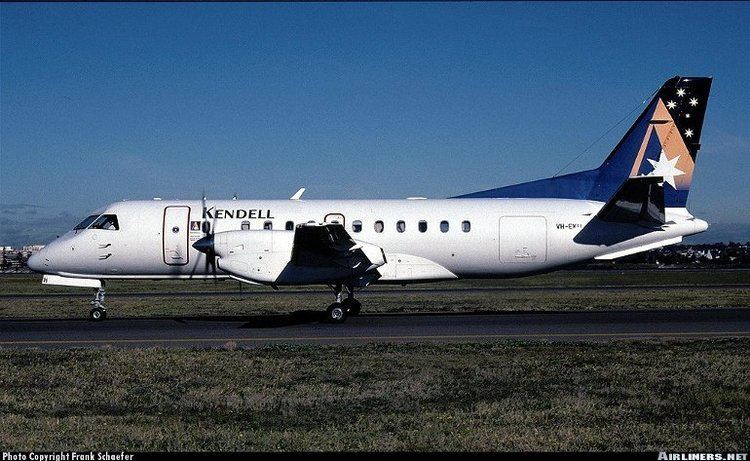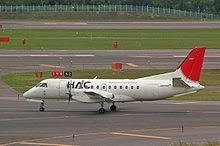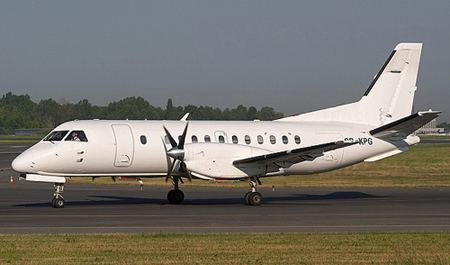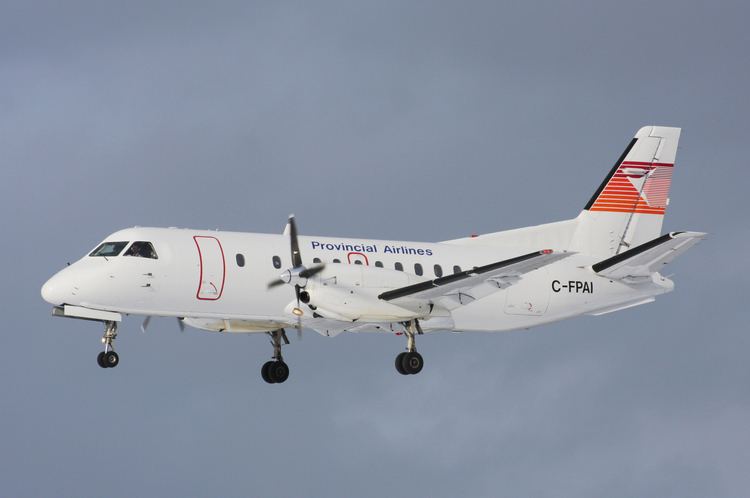Wingspan 21 m Length 20 m Engine type General Electric T700 First flight January 25, 1983 | Top speed 463 km/h Introduced 1983 Manufacturer Saab Group | |
 | ||
Silver airways saab 340 full tour
The Saab 340 is a Swedish twin-engine turboprop aircraft designed and initially produced by a partnership between Saab AB and Fairchild Aircraft in a 65:35 ratio. Under the initial arrangement, Saab constructed the all-aluminium fuselage and vertical stabilizer along with final assembly of the aircraft in Linköping, Sweden, while Fairchild was responsible for the wings, empennage, and wing-mounted nacelles for the two turboprop engines. After Fairchild ceased this work, production of these components was transferred to Sweden.
Contents
- Silver airways saab 340 full tour
- Origins
- Further development
- Operational history
- Variants
- Operators
- Accidents and incidents
- Specifications 340B
- References

On 25 January 1983, the Saab 340 conducted its maiden flight. During the early 1990s, an enlarged derivative of the airliner, designated as the Saab 2000, was introduced. However, sales of the type declined due to intense competition within the regional aircraft market. In 1998, Saab decided to terminate production of the Saab 340.

Origins

During the 1970s, Swedish aircraft manufacturer Saab AB became increasingly interested in the civil aircraft market. In 1974, the company decided to proceed with developing its first major civilian aircraft, having previously focused almost entirely upon military aircraft. During the late 1970s, internal studies had determined that a short-haul airliner should be optimised to seat around 30 passengers. Likewise, it was decided that to make use of turboprop propulsion, which was slower but more economical than turbofan engines, and to optimise the airliner to take advantage of this type of powerplant; this decision may have been influenced by high oil prices during that decade, such as the 1973 oil crisis. According to author Gunnar Elisson, the selection of a turboprop engine made the type less attractive to airlines than jet-powered competitors, however recognised that the General Electric CT7-5A2 engine picked was quite competitive with the jet engines of that era. As conceived, the airliner was to match the performance of jets within its short-haul role.

Towards the end of the 1970s, the regional airliner venture had become the largest industrial venture in Sweden and was recognised as being too large for Saab to conduct alone. Accordingly, in January 1980, it was announced that Saab had entered into a partnership arrangement with US manufacturer Fairchild Aircraft to develop and produce the upcoming regional airliner. Under this partnership, Fairchild became responsible for the manufacture of sections such as the wings, tail unit, and engine nacelles while Saab was responsible for 75 per cent of the costs of development, system integration and certification. To match the new partnership, the type received the designation of SF340. The decision to develop a new generation regional airliner had fortuitously coincided with the removal of control by the US federal government under the 1978 Airline Deregulation Act, an event which would notably contribute to sales of the type during the following decade.

The 340 shared several manufacturing and design techniques that were used in Saab's military aircraft, such as the then in-development Saab JAS 39 Gripen multirole combat aircraft. One such technique was eliminating the use of rivets on the aluminium structures, using bonding instead, to reduce weight. On 25 January 1983, the first SF340 performed its maiden flight. Shortly following its launch onto the market in 1984, the Saab 340 became the best selling commuter aircraft in the world. By 1987, all activity by Fairchild on the programme had ceased, the US company having chosen to curtail its aircraft activities, thus Saab became solely responsible for producing the 340.
Further development

In 1985, due to Fairchild's decision to exit the aircraft manufacturing business following the completion of the first 40 units, Saab dropped the Fairchild name from the project and proceeded to continue aircraft production, referring to the type under the designation Saab 340A. A total of 159 A models were manufactured. In 1989, an improved version of the airliner, the second generation 340B, introduced more powerful engines and wider horizontal stabilizers; later production 340Bs also featured an active noise control system. A total of 200 aircraft were built. In 1994, the final third generation version, the 340B Plus, was delivered for service and incorporated improvements that were being introduced at the same time upon the larger Saab 2000, itself a derivative of the 340. A total of 100 aircraft were completed, adding up to a total of 300 B models. The Saab 340 typically seated between 30 and 36 passengers, with 34 seats being the most common configuration. The last two 340s built were constructed as older configuration 36-seat aircraft for Japan Air Commuter.

One of the major improvements introduced in the 340B Plus was the installation of an active noise and vibration control system in the cabin, reducing noise and vibration levels by about ten dB during cruising flight. This optional feature carried over from the 340B was standard in the 340B Plus along with extended wingtips which was an option on the 340B, about 30 aircraft having the WT option. Another change from earlier models was a more modern interior design and the moving of the lavatory compartment from the aft of the passenger cabin to just aft of the flight deck in most 3rd generation units. This increased total available cargo volume as the original location intruded into the cargo bin area. While the active noise control became standard on all Saab 340Bs in 1994 the first-ever 340B Plus (third B+ built) was delivered new to Hazelton Airlines in Australia in 1995, later operating for Regional Express, and currently for the Japanese Coast Guard. The system could also be retrofitted onto existing airliners.
During the early 1980s, Sweden's Defence Materiel Administration (FMV) requested that Ericsson, a Swedish electronics company, develop a suitable radar for an airborne early warning (AEW) system. The corresponding system was soon paired with the 340 as a platform. Several military variants of the type were produced, including the Saab 340AEW, 340AEW-200 & 340AEW-300, which are AEW and airborne early warning & control (AEW&C) aircraft.
During 1997, Saab was releasing pessimistic press releases on the 340 programme, stating that it was considering the potential closure of production line, but also pledged that it would maintain full support to existing customers if this happened. On 24 December 1997, Saab announced that it had come to the decision to terminate production of the 340, which it claimed had lost SKr3 billion ($386.4 million) in the previous three years. By late 1998, as production was being slowed down towards an eventual shut down, Saab stated that it had been holding talks with a number of interested parties, reportedly including Indian and Chinese companies, on the potential sale of the 340 production line to another manufacturer. On 8 June 1999, the final 340 was delivered, by which time nearly 460 aircraft had been delivered. Production of all models of the 340 was terminated in 1999, and Saab ultimately decided to ceased all civil aircraft production in 2005.
According to Elisasson, the decision to power the type using turboprop engines rather that jet engines had been provided as one of the reasons for Saab deciding to close down the project; another major factor had been the increasingly competitive and politicised regional airliner market in which various competing airlines were alleged to have substantially benefited from government subsidies, while the Swedish government were unwilling to make such commitments to Saab's civil projects. According to authors Sören Eriksson and Harm-Jan Steenhuis, while the 340 had been faster than jet-powered competitors such as the Fokker 100 and British Aerospace 146, it had no clear advantage in terms of payload or range; as the regional airliner market became increasingly crowded, newer types such as the Bombardier CRJ200 and Embraer ERJ 145 family, which did have an advantage over the 340, had led to diminished sales.
Operational history
On 6 June 1984, the Saab 340's launch customer, Swiss operator Crossair, received their first 340 aircraft. One week later, the type performed its first flight with paying customers onboard; passengers onboard this flight included Pope John Paul II.
During 1989, US region airline AMR Eagle placed an large order for the type, procuring a total of 50 340Bs along with options for an additional 50 aircraft. However, business conditions and demand for turboprop-powered regional airliner transformed dramatically during the 1990s; this can be perhaps best summarised by AMR Eagle's decision in October 1999 to announce its intention to phase out its 340 fleet. Faced with diminished value and demand for the 340, Saab chose to shutter production in 1999.
While production of the type ceased in 1999, Saab continued to develop and heavily market the 340 for various purposes in both the civil and military markets. In July 2001, the company announced that it had launched a new partnership with service provider Piedmonth Hawthorne to remarket used regional 340s to corporate customers. In April 2002, it was announced that Canadian company Field Aviation had been contracted by Saab to produce a freighter version of the 340, initially focusing on conversions of the earlier 340A model.
Even after production was terminated, a large number of 340s have remained in commercial service in the following decades. By 2006, there was a resurgence in demand for turboprop-powered airliners, in part due to the rising price of oil; during this year, Saab announced the largest ever leasing deal for the 340, providing a total of 25 340s to Australian operator Regional Express Airlines. By late 2010, Saab was evaluating the option of extending the certified lifespan of the 340 which, under the Maintenance Review Board programme, is typically limited to 60,000 hour; the company believes the maintenance programme could be extended to accommodate up to a 75,000 hour limit.
The existing aircraft have remained relatively active and competitive into the following decade. In late 2008, following a merger between US carriers Northwest Airlines and Delta Air Lines, the latter announced that a new Saab 340 base was being formed in Atlanta, after which the merged airline would replace its inventory of 12 ATR 72s in its regional fleet with 49 form Northwest 340s. During early 2009, Russian operator Polet Airlines conducted talks with American Eagle to lease 25 340s to increase its breadth of regional flights.
During the 2010s, Saab promoted the 340 in the maritime patrol mission. A specialised variant of the aircraft, designated as the 340 MSA, was mooted; the proposed patrol aircraft is to be equipped with various sensors and combat systems to be capable of performing both anti-surface and anti-submarine warfare, as well as signals intelligence and long range search and rescue operations. In June 2014, Anders Dahl, head of Saab Singapore, gave a presentation on the 340MSA, and observed that several nations were in talks with Saab on the type, as well as there being increasing demand for such maritime patrol aircraft in Southeast Asia.
Variants
A stretched derivative of the aircraft, designated as the Saab 2000, was also developed and produced during the 1990s.
Operators
As of July 2015, Saab Aircraft AB reports there were 373 Saab 340s in service with 49 operators around the world having accumulated 15,317,000 flight hours. Nine SAAB 340s have been written off in accidents, six of them without fatalities.
In December 2016, the fleet average is at 35,277 h and 39,446 cycles – a mean 0.89h per flight, less than halfway of its remaining life : the airframe life has been extended from 45,000 to 80,000 flight hours and 90,000 cycles and the Saab 340 should remain in service for another 30 years. Fleet leaders are at 71,268 cycles and 61,867h.
Accidents and incidents
Between 1983 and 2013, there were 13 hull loss accidents involving the Saab 340 series aircraft, resulting in the deaths of 48 people.
Specifications (340B)
Data from Jane's All The World's Aircraft 1993–94, SAAB
General characteristics
Performance
